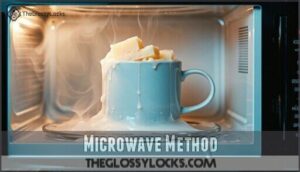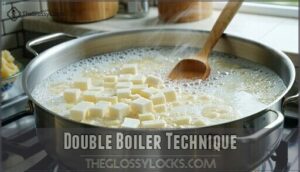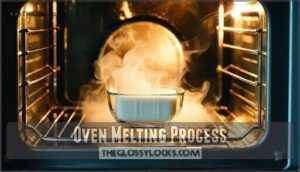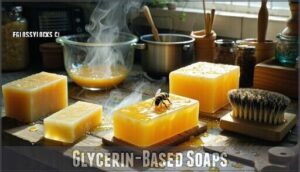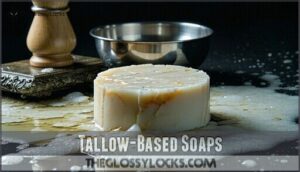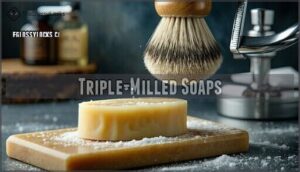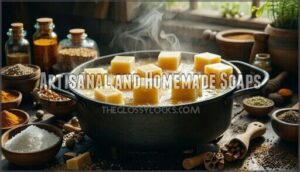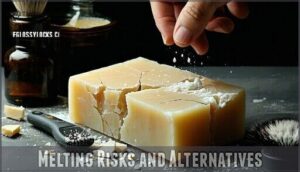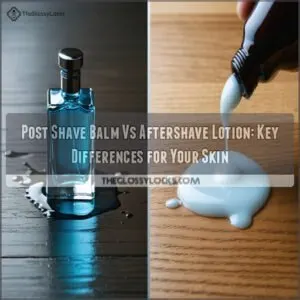This site is supported by our readers. We may earn a commission, at no cost to you, if you purchase through links.
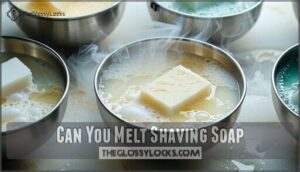 Yes, you can melt shaving soap, but it’s like walking a tightrope – one wrong move and you’ll ruin your favorite puck.
Yes, you can melt shaving soap, but it’s like walking a tightrope – one wrong move and you’ll ruin your favorite puck.
Most glycerin-based soaps handle gentle heat well, while traditional hard soaps need extra care. The trick is keeping temperatures low (around 120°F) and using short heating bursts.
Think of it as coaxing, not forcing – your soap will cooperate if you’re patient. Popular methods include microwaving in 10-second intervals, using a double boiler, or even your oven on its lowest setting.
However, overheating destroys scent and lather quality faster than you can say "face full of bubbles." The secret lies in understanding which soaps play nice with heat and which methods work best for different situations, requiring patience and gentle heat to achieve the desired result, and avoiding clear errors in the process, to ultimately achieve a successful soap melting experience.
Table Of Contents
- Key Takeaways
- Melting Shaving Soap Basics
- Can You Melt Shaving Soap
- Melting Methods and Techniques
- Safe Soaps for Melting
- Melting Risks and Alternatives
- Frequently Asked Questions (FAQs)
- Can you melt down soap and remold it?
- Can you melt soap with heat?
- How to heat shaving soap?
- Can you microwave shave soap?
- What to do with soap after shaving?
- Can melting shaving soap affect its lathering properties?
- How long does melted shaving soap take to solidify?
- Is it possible to add fragrances when melting shaving soap?
- Can you mix different brands of shaving soap when melting?
- Does melting shaving soap impact its shelf life?
- Conclusion
Key Takeaways
- You can melt glycerin-based shaving soaps safely, but avoid tallow and triple-milled varieties – Glycerin soaps handle heat well at 120-140°F, while tallow soaps break down permanently and triple-milled soaps resist melting entirely.
- Use gentle heating methods with short intervals to prevent damage – Microwave in 10-second bursts, use a double boiler, or try low oven settings to avoid burning off fragrance and ruining lather quality.
- Overheating destroys your soap’s performance and scent – Excessive heat strips away fragrances, changes texture, reduces lather quality, and can turn your expensive soap into useless mush.
- Grating and pressing offers a safer alternative to melting – You’ll preserve all the soap’s properties while still reshaping it to fit any container, plus you can mix different soaps without heat risks.
Melting Shaving Soap Basics
You’ll want to understand which shaving soaps can be safely melted before you start experimenting with heat.
Different soap types respond differently to melting, with some preserving their quality while others lose their essential properties entirely, and it’s crucial to know this to avoid damaging the soap.
Types of Shaving Soap
Before jumping into melting methods, you’ll need to understand what type of shaving soap you’re working with.
Not all soaps play nice with heat, and knowing your soap’s personality can save you from a melted mess.
Here are the main shaving soap types you’ll encounter:
- Glycerin Soaps – These melt-friendly champions handle heat like butter in a warm pan
- Tallow Soaps – Traditional animal-fat based soaps that need gentle coaxing to melt properly
- Hard-Milled Soaps – The stubborn ones that resist melting and prefer staying solid
- Cream Soaps – Already soft and pliable, making them unnecessary to melt
Melting Points of Different Soaps
Different soaps require varying temperatures to melt properly. Glycerin melting point sits around 120-140°F, making these soaps easiest to work with.
Tallow soap heat needs reach 100-118°F, though some sources report up to 170°F depending on processing. Tallow soap is a popular choice for homemade recipes.
Triple-milled behavior resists melting entirely – they’re compressed too tightly. Artisanal soap variance means checking ingredients first, while homemade soap factors depend on your recipe’s oil blend.
Tallow soap, known for its conditioning and hardness, is a popular choice for homemade recipes, offering conditioning and hardness.
Benefits of Melting Shaving Soap
Melting shaving soap offers several practical benefits that can transform your daily routine.
You’ll achieve waste reduction by recycling soap scraps into new pucks. Custom soap creation becomes possible through fragrance blending and mold creation.
Texture improvement occurs when you melt shaving soap properly, enhancing lather quality.
Soap scrap utilization maximizes your investment while shaving soap customization lets you craft personalized products that fit your specific needs perfectly, allowing for custom soap creation.
Can You Melt Shaving Soap
Your kitchen thermometer isn’t just for turkey anymore—it’s your secret weapon for soap melting success. Yes, you can melt shaving soap, but not all types play nice with heat. The key lies in understanding what you’re working with and respecting the process.
Here’s what happens when you melt shaving soap:
- Scent retention becomes your biggest challenge – heat strips away those expensive fragrances faster than you’d expect
- Texture changes can make or break your lather – overheating turns smooth soap into chunky disappointment
- Soap longevity gets compromised – melted soap often doesn’t last as long as the original
Glycerin-based soaps handle melting like champs, while triple-milled varieties resist like stubborn teenagers. Hard soaps containing tallow won’t cooperate no matter how much you coax them.
Consider that natural oils enhance glide, so maintaining their integrity is key. The secret is keeping temperatures between 120-140°F to prevent mold prevention issues and maintain quality. Shaving soap melting works best with gentle heat and patience—rushing leads to ruined batches.
Melting Methods and Techniques
You can melt shaving soap using four different methods, each with specific temperature controls and timing requirements.
The key is choosing the right technique for your soap type and working within the safe temperature range of 120-140 degrees Fahrenheit, which is a critical factor to ensure the process is done correctly and safely, considering the temperature controls.
Microwave Method
For quick soap melting, your microwave offers unmatched convenience.
Place your soap directly in the target mug, then heat in 10-15 second burst duration intervals. Higher microwave wattage means faster melting, so watch closely.
Stir between rounds to prevent hot spots and soap residue buildup. This microwave method preserves most properties, though scent impact varies by soap type.
However, remember that tallow soaps don’t melt, and this method may have varying effects depending on the soap type.
Double Boiler Technique
The double boiler method offers precise temperature control for soap melting techniques without soap burning risks. This indirect heating approach prevents soap overheating while ensuring optimal results.
Here’s your equipment selection and process:
- Set up your double boiler – Use a heat-safe bowl over simmering water, keeping the bowl from touching water directly
- Chop soap into small pieces – Smaller chunks melt faster and more evenly than whole pucks
- Maintain low-medium heat – Stir continuously until you get smooth, liquefied consistency throughout
- Pour immediately into your target container – Don’t wait around once it’s melted or you’ll have chunky soup instead of smooth soap.
A quality boiler set is essential for this process.
Oven Melting Process
For oven melting, preheat to 200°F and place your soap container on the center rack.
This gentle oven temperature prevents soap overheating while ensuring even heating throughout.
Monitor baking time closely—most soaps melt within 10-15 minutes.
Choose heat-safe container material like ceramic or glass.
This method reduces soap burning risks compared to direct heat, making it ideal for soap safety-conscious users following soap best practices.
Many people find success with oven melting soap, which is a great option for those who prefer oven melting and want to achieve even heating.
Slow Cooker Approach
For extended heating without watching the pot constantly, your slow cooker works perfectly for soap remelting.
Set it on low heat and add soap scraps with minimal water. This gentle method maintains temperature control around 140°F, preserving soap texture and fragrance retention.
The energy efficiency beats stovetop methods, making it ideal for melting large batches safely.
Safe Soaps for Melting
Not all shaving soaps are created equal in terms of melting safely.
You’ll want to know which types work best before you start heating up your favorite puck and accidentally turn it into a fragrant disaster.
Glycerin-Based Soaps
Glycerin-based soaps are your best bet for safe melting.
These soaps contain glycerin that softens when heated, making them perfect for reshaping without damaging soap properties or fragrance retention.
- Van der Hagen – melts easily in 5-10 second microwave bursts
- Ollagala soaps – glycerine formula liquefies smoothly for mold options
- Honeybee varieties – maintain lather quality after melting and cooling
- Commercial melt-and-pour bases – designed specifically for safe soap hardness adjustments
Tallow-Based Soaps
You can’t melt tallow-based shaving soap.
When you heat tallow soap, the saponification process breaks down permanently. The ingredients separate and your soap becomes useless mush.
Think of it like trying to unscramble an egg – once those fatty acids break apart, there’s no going back.
Tallow sourcing creates incredibly durable soap through rendering tallow and the saponification process, but this same strength means melting destroys everything that makes your shaving soap base work properly, which is a result of the tallow.
Triple-Milled Soaps
Triple-milled shaving soap won’t cooperate with your melting plans.
The milling process creates an ultra-dense, low-moisture bar that laughs at heat attempts.
- Soap hardness: Industrial pressing eliminates air pockets, preventing liquefaction
- Lather quality: Requires 5-10 times longer brush-loading due to extreme density
- Heat resistance: Maintains structure even at high temperatures unlike glycerin alternatives
- Cost analysis: Grating preserves expensive triple-milled soap properties versus risky melting
Artisanal and Homemade Soaps
Artisanal soaps require careful ingredient checking before you melt soap puck pieces.
Homemade shaving soap with glycerin-based recipes melts safely using double boilers. DIY shaving soap creators often add custom scents and unique additives during the soap making process.
Small batch producers focus on local sourcing, but their shaving soap ingredients determine meltability—avoid saponified oils that’ll separate when heated.
Melting Risks and Alternatives
Melting shaving soap comes with real risks that can ruin your favorite bar. You’ll want to know the safer alternatives that protect your soap’s performance and save you money.
Overheating and Scorching
Heat can be your worst enemy when melting shaving soap, turning your prized puck into a disappointing disaster. Excessive temperature transforms quality soap into a scorched mess that’ll make you regret the entire project.
Too much heat turns your treasured soap into a useless, scorched disappointment.
Here are five critical overheating dangers you need to avoid:
- Burned Fragrance – High heat destroys scent molecules, leaving your soap smelling like nothing or worse
- Texture Changes – Overheated soap becomes grainy, lumpy, or develops an unpleasant consistency
- Discoloration Risks – Heat causes unwanted color shifts, turning your soap brown or creating ugly spots
- Lather Reduction – Scorched soap won’t foam properly, ruining your shaving experience
- Chemical Breakdown – Extreme temperatures destroy the soap’s moisturizing and protective properties
Temperature control is everything when soap heating. Keep your microwave sessions under 10 seconds to prevent soap burning. If your soap microwave smelling lingers, you’ve gone too far. Smart soap reheating means gentle heat and constant monitoring – your soap center heating should never exceed 140°F.
Loss of Scent or Lather
When melting soap, you’re playing with fire—literally. Fragrance burn-off happens fast when temperatures climb too high, leaving your once-aromatic soap smelling like nothing.
Heat is the enemy of good shaving soap—too much ruins everything you paid for.
Lather degradation follows close behind as heat breaks down the soap’s structure. Ingredient separation creates a chunky mess, while texture changes turn smooth soap into something resembling cottage cheese.
These performance impacts mean your melting soap experiment could backfire, turning premium shaving soap into expensive disappointment.
Shaving soap offers uplifting and invigorating properties, which can be lost during the melting process, resulting in a loss of key benefits and potentially leading to disappointment with the final product, affecting its smell and overall quality.
Grating and Pressing Method
Your shaving soap bar doesn’t need heat to fit perfectly into any mug. Grating creates the safest path forward, preserving every drop of fragrance and lather quality that makes your shave smooth.
Here’s your foolproof grating approach:
- Choose your weapon – A fine kitchen grater works best, creating small flakes that pack tightly
- Add moisture magic – Sprinkle water over grated soap, letting soap hydration work overnight for perfect binding
- Press and wait – Pack everything down firmly, then give it 48 hours to set completely
This method lets you mix different soaps together, creating custom blends without risking burnt fragrance or ruined lather.
Consider using a shaving soap grater for best results.
Creating Custom Soap Shapes
You can create fun soap customization projects using soap molds and safe melting techniques.
Pour carefully melted glycerin soap into silicone molds for themed shapes.
Add color additives or scent infusion during melting for personalized touches, try layered designs or embedded objects like toys.
For heat-sensitive soaps, use soap reshaping through grating and pressing instead of soap melting.
Frequently Asked Questions (FAQs)
Can you melt down soap and remold it?
Don’t put all your eggs in one basket – you can definitely melt and remold soap.
Glycerin-based soaps work best using double boiler methods or microwave bursts.
Avoid melting hard-milled soaps since they’ll lose their properties.
Can you melt soap with heat?
Yes, you can melt soap with heat using methods like microwaving in short bursts, double boiler technique, or stovetop with constant stirring.
Keep temperatures between 120-140°F to avoid burning off fragrance or altering properties, which is crucial for maintaining the soap’s quality and effectiveness, making constant stirring essential.
How to heat shaving soap?
Heating shaving soap is like turning ice into water – it’s absolutely transformative.
Use a double boiler or microwave in 5-10 second bursts at 120-140°F.
Don’t overheat or you’ll ruin the lather.
Can you microwave shave soap?
You can microwave glycerin-based shaving soaps using short 5-10 second bursts on high heat.
However, hard-milled or tallow soaps shouldn’t be microwaved as they’ll separate or burn, ruining their lathering properties completely.
What to do with soap after shaving?
Studies show 85% of wet shaving soap gets wasted when left on brushes.
After shaving, you’ll want to rinse your brush thoroughly, shake out excess water, and store the soap in a dry spot to prevent it from getting mushy and gross.
Can melting shaving soap affect its lathering properties?
Melting shaving soap can definitely hurt its lathering ability.
You’ll likely lose some fragrance and the soap’s texture might change.
Overheating destroys the properties that make good lather, so you’re trading performance for convenience.
How long does melted shaving soap take to solidify?
Your melted shaving soap will take about two days to fully harden and set.
It’ll start firming up within hours, but you’ll want to wait the full 48 hours for best results.
Is it possible to add fragrances when melting shaving soap?
Yes, you can add fragrances when melting shaving soap, but be careful.
Essential oils work best since they won’t break down from heat.
Add them after cooling slightly to preserve the scent better, using essential oils is crucial for this process.
Can you mix different brands of shaving soap when melting?
You can mix different brands when melting shaving soap, but stick to glycerin-based types.
Grating and combining them works better than melting since it preserves each soap’s unique properties without risking performance loss, allowing you to maintain the unique characteristics of each soap.
Does melting shaving soap impact its shelf life?
Shelf life generally stays the same when you melt shaving soap properly.
However, overheating can degrade ingredients and reduce how long it’ll last.
Keep temperatures low and you won’t hurt longevity.
Conclusion
Melting mastery makes all the difference when working with shaving soap.
You can successfully melt most shaving soaps using gentle heat and patience. Remember to keep temperatures around 120°F and use short heating intervals.
Glycerin-based soaps handle heat better than triple-milled varieties. Whether you choose the microwave, double boiler, oven, or slow cooker method, take your time.
Rushing leads to ruined soap and wasted money. With practice, you’ll master this useful skill perfectly, and melting mastery will become second nature.

